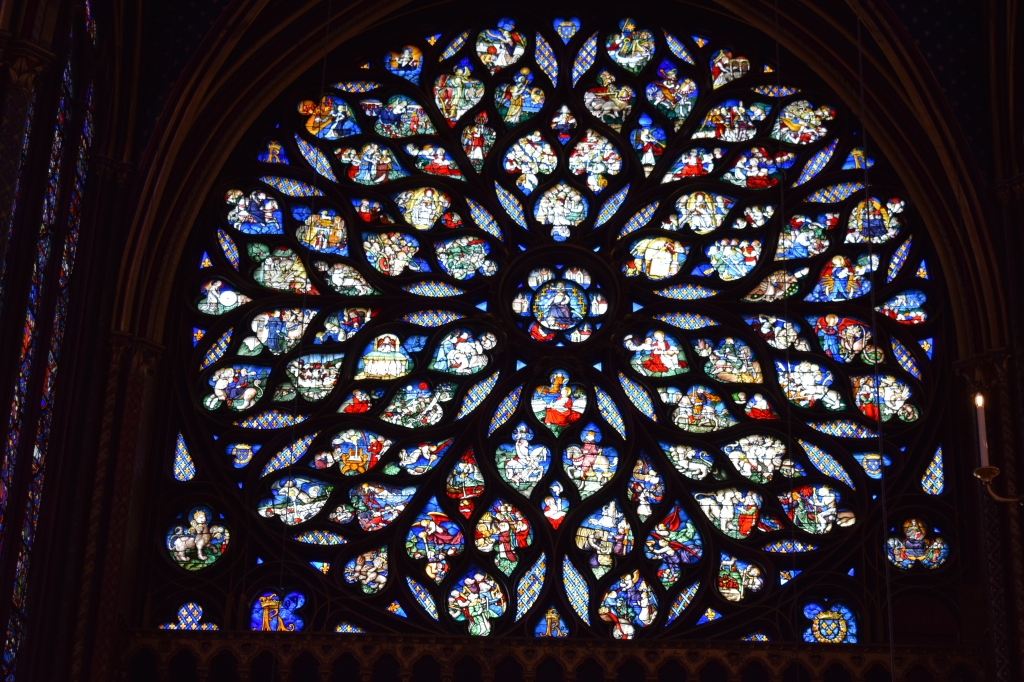I recently had the pleasure of visiting Paris for a weekend, and with my limited time I knew I needed to go and visit a stunning medieval marvel that I’ve wanted to see for years. My visit most certainly did not disappoint, and so I had to share the history of this wonderful place with you all. The Sainte-Chapelle was constructed in the middle of the 14th century and is considered one of the crowning glories of French Gothic architecture, so read on to learn more…

Louis IX of France came to the throne in 1226 when he was just twelve years old. He ruled for over 40 years and became well known for his piety and championing of Christianity. He led two Crusades – being captured and ransomed during the first and dying of dysentery or the plague during the second – but also spearheaded reform within French lands. He enacted harsh laws against blasphemy, made moves against France’s Jewish population, and was so dedicated to enforcing Catholic doctrine that he was occasionally criticised by his contemporaries. Despite this, he was immediately venerated by his subjects after his death, and within three decades he was made a saint by the Pope – the only king of France to have attained this honour.
Louis’ interest in and dedication to Christianity provided him with a goal to collect relics, something he shared with many other medieval Catholic monarchs. The Latin Emperor, Baldwin II, was in possession of the Crown of Thorns, one of the holiest of all relics. However, he was also in a dire financial situation and had been forced to pawn the Crown to Venetian creditors. This provided an opportunity for the wealthy French king, who paid off the creditors for Baldwin in exchange for the Crown, at a cost of half the annual income of his kingdom: 135,000 livres tournois. Within the next few years, Louis had obtained another 22 relics and decided that he needed a glorious chapel to house them all.

For such holy, priceless relics, the building needed to be glorious in order to reflect the glory of God (and of the king himself). Construction of the Sainte-Chapelle began in 1241 and Louis had grand visions for the design. He wanted the chapel to be on the site of his palace on the Île de la Cité so that he had ready access to the relics. The architectural style would encapsulate the popular Gothic style whilst being inspired by other famous royal French chapels. The Sainte-Chapelle was formed of one huge room 36 metres long and nearly 43 metres high, rivalling the size of some cathedrals. This upper level where the relics themselves were kept was only accessible to the royal family and those they chose to bring with them. The lower chapel, which was a much more modest 6.6 metres high, was the domain of courtiers, soldiers, and servants. The chapel was also directly accessible by Louis and his family from the palace.


Views of the upper chapel. Images author’s own.
The size of the Sainte-Chapelle was not the only thing which was made to impress. Fifteen bays fifteen metres high split the walls into sections filled with stained glass. This was a monumental project, showcasing 1,113 scenes across more than 670 square metres. Today, the chapel is one of, if not the, most extensive collections of 13th-century stained glass in the world. To support such staggering amounts of glass, clever solutions were found. Iron chains brace the walls and windows on the outside, hidden from within by the bars which hold the glass. There are further metal supports hidden under the eaves of the roof, and the supporting columns and supports, whilst appearing slender, are actually very thick. The scenes begin in the left window of the north wall and circle all the way around the chapel to the south. The scenes portray the history of the Bible, beginning with Genesis and ending with Louis himself carrying the relics into the newly-constructed building. The story was completed on the west façade with a rose window depicting the apocalypse which was replaced by another more elaborate one in the 15th century.

The glass was not the only decoration in the Sainte-Chapelle. Both the upper and lower chapel were painted in bright colours and patterns, most prominently the French blue with fleur-de-lys. A variety of creatures and plants can be found painted on the floors or sculpted on the columns, whilst internal buttresses painted in golds, greens, reds and blues add further feasts for the eyes. On the outside sits a huge spire that rises above Paris, today standing at 75 metres above ground (it being the fifth spire since the chapel was built).
Some of the other decorations in the Sainte-Chapelle. Images author’s own.
The Sainte-Chapelle was certainly a monumental construction in all senses of the word. It took seven years to build at a cost of 40,000 livres tournois and brought huge prestige to France. In the following centuries numerous additions were made around the chapel, including a two-storey archive and an enclosed staircase connecting the courtyard to the upper level. A fragment of Louis’ skull was added to the collection of relics in 1306. The chapel also experienced numerous disasters: fires in the palace in 1630 and 1776 caused damage to the building, whilst a flood in the winter of 1689-90 severely damaged the lower chapel, in particular the wall paintings. This necessitated several major repair and restoration projects.

Enjoying this blog post? Buy me a hot chocolate!
Consider donating the cost of a hot chocolate to me, so I can continue to write and run Just History Posts.
£3.50
With the advent of the French Revolution, the building was irrevocably changed. The Sainte-Chapelle became a target for revolutionaries both because of it being so intrinsically linked to the French monarchy, and for the beacon of Christianity it represented. Sculptures and royal emblems were smashed, the spire was pulled down, some of the stained glass was broken or sold and most of the relics were dispersed. The stunning silver chest which held the relics that Louis had constructed centuries before at a staggering cost of 100,000 livres was melted down. Only the most famous Crown of Thorns was kept. The chapel, which was once one of the most holy buildings in France, was then turned into a flour warehouse.


The exterior of the Sainte-Chapelle today and in 1630. Sainte-Chapelle/ Centre des monuments nationaux.
After the revolution, the Crown of Thorns was transferred to the treasury of Notre-Dame Cathedral, and the Sainte-Chapelle became an archive depository. It remained this way for three decades and came close to destruction. However, by the late 1830s public opinion had changed, and significant French figures including the author and politician Victor Hugo campaigned for its protection. Between 1840 and 1863 a vast restoration project was undertaken with the aim to restore it as far as possible to its original 13th-century appearance. New techniques for restoration and conservation of historical monuments were employed, with statues being repaired or rebuilt and the walls of the lower chapel being re-painted.

Despite the centuries of disaster and destruction, the Sainte-Chapelle stands today in a remarkably original state. Two-thirds of the stained glass windows remain from the medieval period providing a remarkable insight into the skills and form of the techniques employed. It is possible to stand within and view it in a state that would not have been unfamiliar to Louis IX eight centuries ago. A more recent restoration project was undertaken in 2008 in order to clean and preserve the stained glass, which had darkened from protective varnish applied to it during the Second World War to protect it from bomb damage. Around €10 million was spent to complete this, as well as to clean the stonework and repair some of the sculptures.

The Sainte-Chapelle was never restored to its original function as a place of worship, but it is open today to visitors between April and September. Tickets are €13 with discounts or free entry available for certain groups. Entrance is operated by time slot to manage the amount of people inside at once, and whilst you do not need to book in advance this is highly encouraged; we certainly found extensive queues even with a booked slot. For up-to-date information, always check the website.
The Sainte-Chapelle can certainly claim its place amongst the marvels of the medieval world. One of the greatest buildings of its time, its grandeur, beauty, and construction skill still awe visitors today. Built to house some of Christianity’s holiest relics, it also became a symbol of the personal piety of its founder and of the glory of the French monarchy, and it managed to survive the ravages of the French Revolution fairly intact. It was truly wonderful – breathtaking – to visit, and I would highly recommend it to anyone who has the opportunity to do so.
Did you know that Just History Posts now has a newsletter? Be sure to sign up here!
Previous Blog Post: Book Review: “I, Christine” by Marcia Maxwell
Previous in Medieval Marvels: Royston Cave: An Unexplained Enigma
List of Blog Posts: here Blog Homepage: here
Buy my books via the pictures below! Or why not check out our shop?

Follow us:
Read more:
https://www.sainte-chapelle.fr/en
https://www.britannica.com/place/Sainte-Chapelle









